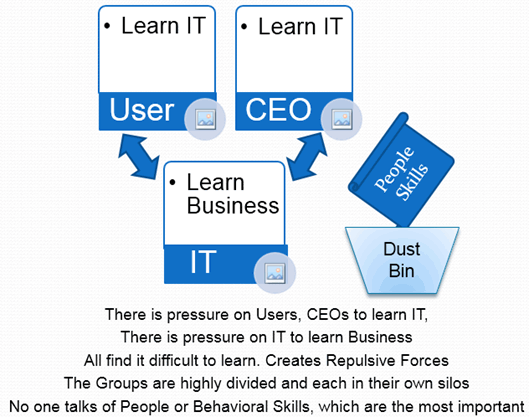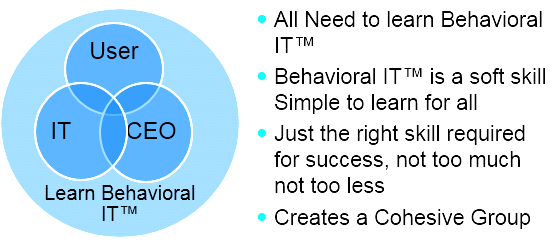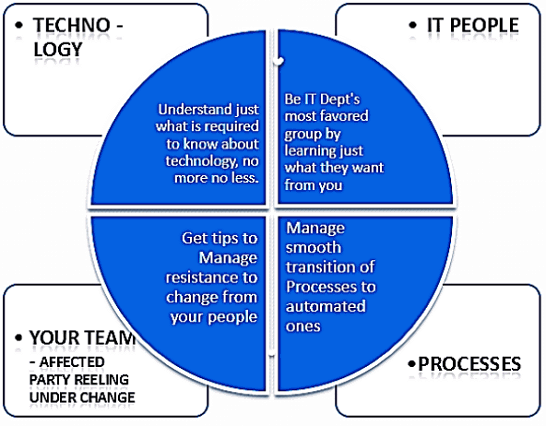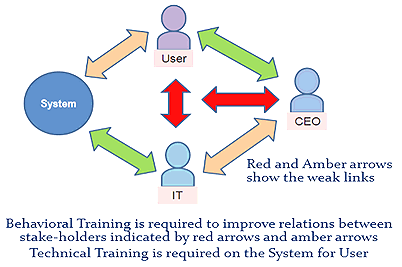| Copyright © 2019-22 Prem Kamble | |||||||||||||||||||||||||||||||||||||
Behavioral IT®: A Multi-disciplinary Approach
to Address the IT Woes of Businesses & Top Professionals in an IT-Driven World |
|||||||||||||||||||||||||||||||||||||
| Related Articles || Published in Journals | |||||||||||||||||||||||||||||||||||||
|
This paper was presented at the "National Conference on Contemporary Trends in Management Research" in Bangalore on August 30, 2019 and has been published in "International Journal of Advance and Innovative Research",
Volume 7, Issue 3 (II): July - September, 2020 (ISSN 2394 - 7780).
This article has also been published as an academic paper in 8 international management ejournals like Information Systems eJournal,
Leadership & Organizational Behavior eJournal,
Human Resource Management & Organizational Behavior eJournal,
Change Management Strategy eJournal,
Project & Program Management eJournal,
etc.
Click here to see full list of journals with Issue date and Issue number.
Summary
The paper introduces a unique multi-disciplinary approach called "Behavioral IT®" which addresses the IT-Disruptions related woes of both businesses and business professionals like CXOs, Top Managers and Management Students
Businesses experience problems of huge losses due to over 70% IT Projects Failures. There is efficiency-drop due to IT-disruption induced conflicts, blame-game and politics. Business Professionals/CXOs/Top Professionals experience problems like fear of obsolescence and a feeling of uneasiness ("I don't know IT")
This paper presents two simple solutions for both problems: For Businesses, it introduces the Behavioral IT Model for IT Transformations, and for CXOs/Managers/Management Students, it trains them on Behavioral IT Soft-Skills.
Behavioral IT is a unique, multidisciplinary behavioural approach for both Business & Individual Success in an IT-Driven World which bridges what the author calls the "Corporate Digital Divide". It is a study of evolution of human psychology from the industrial-age mindset to the information-age paradigms.
Click on Related Articles to see many more articles and research papers on Behavioral IT®
ABSTRACT
This paper introduces a unique multi-disciplinary approach called Behavioral IT® which addresses the IT-Disruptions related woes of both businesses and business professionals like CXOs, Top Managers and Management Students Businesses experience problems of huge losses due to over 70% IT Projects Failures. There is efficiency-drop due to IT-disruption induced conflicts, blame-game and politics. Business Professionals/CXOs/Top Professionals experience problems like fear of obsolescence and a feeling of uneasiness ("I don't know IT")
This paper presents two simple solutions for both problems:
Behavioral IT is a unique, multidisciplinary behavioural approach for both Business & Individual Success in an IT-Driven World which bridges what the author calls the "Corporate Digital Divide". It is a study of evolution of human psychology from the industrial-age mindset to the information-age paradigms. Though researchers identified the cause of IT failures over 30 years back as "Lack of Top-Management Participation", the problem persists with 70-80% failures today - because researchers haven't found answers to 2 basic behavioural questions, which are the root cause:
This paper fills this long-standing gap in research on IT failures in Businesses (particularly lop-sided focus on Behavioral aspects), and ensures success by transforming:
This paper is useful for all CXO's, managers, heads of companies and heads of departments - in short, for all the change drivers or change catalysts in businesses. It is of course useful for students of management too. CEO's and Business owners can benefit by improving their business in an IT-Driven world by ensuring IT projects succeed. CEO's, Top Managers and management students can benefit by honing their skills to succeed in a dynamic IT-Driven world and grow professionally. Keywords: Behavioral IT, IT Failures, IT Project Implementation, Why IT fails, Key Success Factors for ERP Implementation, IT-Driven Change Management, Psychology of Change, Socio-Technical Change, IT Soft-Skills, IT for Corporate Leaders CHAPTER 1: INTRODUCTIONWrite to Me | Comments | Related Articles | Top We live in an era of significant disruption driven by the rapidly evolving IT landscape. Such a dynamic scenario provides severe challenges to not only the businesses, but also to the working professionals who struggle to cope with IT-induced changes. This paper introduces a unique, multidisciplinary approach known as Behavioral IT® which addresses the IT woes of the corporate world, specifically:
IT Woes of CXOs and Top Professionals are:
IT Woes of Businesses are:
Behavioral IT is a Unique, Multidisciplinary Behavioural approach for success of both Business & managers in an IT-Driven World. RELIEF FOR IT-WOES OF EMPLOYEES/LEADERSChange, as usual is the root cause of the IT woes. No wonder, as IT is the biggest driver of change today. The most needed and exclusive IT-skill today for Managers/Management students is not just managing change, but managing IT-Driven Change, which is a very specialized skill. Unfortunately, today's Change-Management does not adequately cover IT-Driven Change. Behavioral IT provides big relief to Managers with just the required skills to excel with IT- no more, no less. With easy-to-learn Behavioral IT Soft-Skills, managers don't need to learn difficult IT Hard-Skills.
Behavioral IT works by-
Behavioral IT is a rare mix of Technology, Psychology and Behavioural skills. Behavioral IT® transforms Managers to 'Catalysts of IT-Driven change', not 'Barriers-to-Change' RELIEF FOR BUSINESS IT-WOESResearchers found root cause of IT failures over 30 years back as "Lack of Top-Management Participation". Yet there is no respite, with 70-80% failures today and the severe friction with blame-game continues. The problem persists because researchers haven't found answers to 2 behavioural questions:
Behavioral IT Model for IT Transformations fills this long-standing gap in research and ensures IT success through:
This paper attempts to fill several more gaps in IT research, particularly about lop-sided focus on Behavioral aspects and lop-sided emphasis on training. Though this paper focuses on IT-Driven change, the core principles can be applied to managing any change, because people and behavioural issues are at the centre of any change. MYTHS OF IT WORLDThis paper also busts two myths
IT is the biggest driver of change today which bothers employees. The most needed and exclusive IT-skill today for Managers/Management students is not just managing change, but managing IT-Driven Change. Ironically, Change-Management courses rarely cover IT-Driven Change. Behavioral IT provides big relief to Managers with just the required skills to excel with IT- no more, no less. With easy-to-learn Behavioral IT Soft-Skills, managers don't need to learn difficult IT Hard-Skills. Behavioral IT works by-
Behavioral IT® is a rare mix of Technology, Psychology and Behavioural skills. It transforms Managers to 'Catalysts of IT-Driven change', not 'Barriers-to-Change' Being an industry professional, the author's research is based on practical experiments during his over 30 years of experience of developing and implementing IT solutions. He has found that IT failures are rarely due to technology issues. Most often failures are due to behavioural and organizational issues. Behavioral IT attempts to correct some deep rooted assumptions and industrial-age paradigms of the mind, which need to be replaced by information-age paradigms. CHAPTER 2: IT EUPHORIA: REAL OR MISPLACED?Write to Me | Comments | Related Articles | Top IT SCENARIO LOOKS SO ROSY - WHO SAYS THERE IS A PROBLEM?When one talks of problems in IT Transitions, IT Adoption and failures of ERP implementations, the most common reaction is that of utter surprise and denial. When they see social media and gadgets/tools like laptops, mobile, PowerPoint, etc. being so easily adopted, it is hard for them to believe that IT adoption in companies has issues. They almost revolt, saying, "IT scenario looks so rosy, where do you see a problem?" No wonder, there is a lot of euphoria about IT. Most people have a misconception that everything is hunky-dory in IT. But reality is different. Where is the fallacy? SUCCESS OF FACEBOOK, ETC. MAY BE MISLEADINGThere are two simple reasons why Facebook and Corporate IT are completely different and why there are umpteen problems in corporate IT:
The skills required for IT success in businesses are more managerial than technical. In a nutshell, when people are involved in a collaborative, interdependent process, there is bound to be disruption, resistance, blame game, conflict and stress. PICTURE IS NOT SO ROSY AS IT APPEARSThough things may look very rosy from outside, ground reality in businesses is actually quite opposite. There is a huge turmoil during IT-transitions, stress and friction between stake holders resulting in blame game and politics. There is a big divide between IT and the user departments and most often the top management remains a helpless witness, not knowing how to handle these disputes. Top Business Professionals are confused and stressed as they are unable to cope with IT-Driven Change. They don't know what to learn to equip themselves and end up trying to learn complex technology or programming, or technical details, which, as this paper shows, they need not learn. No wonder, they find IT too complex. Senior managers feel insecure worrying that the younger generation is more IT-Savvy. They feel that the younger generation will make them obsolete. On the other hand the GenY has a misconception that it is very IT-Savvy just because they are much better at using gadgets and software tools. They are unaware that what businesses need is not IT literacy but IT awareness. Today Businesses are struggling to cope with rapid changes in business environment and ground rules. Enough research has been done on helping businesses to manage change. Change management courses and seminars have been in existence for decades. But there is something seriously lacking in the way change management is being addressed. In today's world, technology, particularly Information technology (IT) is the biggest and most aggressive driver of change. While Information technology is changing by the day, Change management techniques have remained traditional and more or less the same over years. In particular, they have not evolved to include content which educates you on how to manage the most significant change, i.e., IT-Driven change. And managing IT-driven change needs specific skills very different from managing normal change. This has resulted in major failures in IT projects and huge losses for businesses. The IT projects, particularly ERP projects fail because not enough emphasis is laid on behavioral aspects of managing the resultant change due to deploying or implementing the IT projects. Even if emphasis is laid, the change is managed without specific skills for managing IT-Driven change. IT failures result in huge losses in cost and time, leave alone the indirect cost due to fall in efficiency during implementations and the stress and politics caused by friction during change. IT Experts have estimated a failure rate of almost 70-80% in ERP projects. The immense loss due to this failure cannot be imagined. It is strange that not much progress has been made in research to reduce this huge loss to industry and pain area/stress-generator for corporate employees. When I refer to IT transitions, I would be mostly talking of ERP software implementations. The figures of 70-80% IT failures too refer to ERP failures. We look at the IT woes of the corporate world, but first from the point of view of individual managers and then from the point of view of businesses and groups of managers - because individuals and people are the most important actors in any change. We look at what goes on in the minds of individuals first and then look at the mess in the business processes of IT transitions/IT implementations. CHAPTER 3: IT WOES OF EMPLOYEES/MANAGERSWrite to Me | Comments | Related Articles | Top To know the IT Woes of corporate managers, it is important to study what goes on in the minds of the managers during ERP implementation, and how it finally impacts the outcome of the IT project PERSONAL ISSUES OF TOP MANGERS1. Most top managers harbour an innate fear of IT and a complex that the younger managers are more IT aware than they are. The worst is when the CEOs have this complex - then they avoid getting involved and tend to push all IT work to COO, CFO, etc. Most managers even fear that they will make a fool of themselves in front of their juniors because of their ignorance. In effect, they don't get involved in driving the change process and that becomes the primary cause of failure. 2. Managers are very eager to learn because of their subconscious complex ("I don't know IT"), but they simply do not know where to start, and what to learn. They end up trying to learn the wrong stuff and find it too tough and give up saying "IT is not for me". 3. Most Managers would like to make the best use of IT, streamline their processes and information systems for better control, and to reduce their stress at work. But they fell flat in their last attempt to automate processes with the help of the IT department folks. Their experience with both IT and the IT folks was nowhere near satisfactory, on the contrary it was frustrating. They always thought that the IT folks could not give them what they wanted though the IT department had a magic wand in their hand. 4. What they got was far below expectations, and most importantly, the tedium of the transition was completely unexpected. They had thought that IT would be a panacea to all their problems and they never expected that they would have to work so hard to get so little. All this obviously led to frustrations, anger, blame game and a total rejection of the capabilities of the IT folks. The user departments always thought that the IT folks did not know business at all, and the IT folks complained that the user department did not know IT. Net result was that there was a big rift between the IT department and user department. You, as a manager, are clearly not in control. CHANGE IS DISRUPTIVEChange is always disruptive, but IT-Driven change is more confusing and stressful because it appears mysterious. A manager not only needs to adapt to change, but is expected to drive change. Moreover a manager needs to manage people who are themselves struggling to cope with the impact of IT-driven change, who are agitated and who naturally resist change reeling under IT-driven change and tend to resist change. CHAPTER 4: IT WOES OF BUSINESSESWrite to Me | Comments | Related Articles | Top IT FAILURESAs stated earlier, IT researchers like Aberdeen and Gartner estimate the IT Project failure statistics to above 70%. The result is massive losses for businesses. THE GREAT DIGITAL DIVIDE IN CORPORATESThe conflict between the IT User and IT department was already discussed above. But apart from the IT-User divide, there is a big divide between the IT-Department and top management too. This results in blame-game, politics and leg-pulling. There is more conflict and little collaboration. If IT-department, User-dept. and top-management can convert conflict into collaboration, IT-failures will reduce drastically. Behavioral IT® does exactly that. TURMOIL OF IT-TRANSITION1. Setting the PerspectiveThe entire process of automation, mainly an ERP implementation process, is a very turbulent time where the people involved in the transition or automation process go through a major disturbances. It is important to give a realistic picture of the inter-personal problems faced during automation, because most people look at computerization as a technical problem and are not even aware that there are inter-personal issues or behavioral issues. Typically, any IT implementation consists of phases
2. Issues During System StudySeveral ERP projects fail because of improper requirements study. Typical people problems during study are non- availability of right resources from the user-department to educate the IT department, inadequate skills of IT folks, under-estimation of the complexity of the business processes, lack of willingness to re-engineer processes. It is a common complaint of the IT department, that the user folks, particularly the senior managers and department head, were too busy and unavailable for discussions. An IT solution developed after such poor study is like building a castle on a weak foundation. 3. Failure due to Improper EstimatesAnother human issue which becomes a cause of IT failure is the pressure and succumbing to pressure to cut time and cost of the project. Typically, IT department gives an estimate of time and cost. There is immense pressure to cut cost and time. The IT Head, in some cases not being senior enough to resist pressure from the top, buckles under pressure. The result is a solution that is not robust or well documented. 4. Unawareness of People Issues of Parallel RunA manager needs to know the mental state of the people involved in this change and be able to empathise with them. Sometimes, some employees have fear of losing their jobs due to automation. If they don't lose a job, they certainly fear loss of control. There is of course always the fear of the unknown. They are all agitated and pained, because any change is painful. Many IT projects fail due to natural resistance of the employees involved, and it is very important for the manager to understand the dynamics of IT-Driven change. 5. Political Game During Parallel RunsParallel run is the most turbulent phase of the entire IT transition cycle. This is the phase when most number of people of all varieties and levels are involved. Parallel run is the phase when the new solution is used on a trial basis whereas the old system (whether manual or on an old solution) continues to be used. This results in duplication of work and puts huge pressure on the user team. Such pressure becomes a good breeding ground for politics and finger pointing. Small problems lead to immediate escalation. Very few CEOs and HoDs can handle this situation well and it becomes the cause of failure. The very purpose of parallel run is to identify bugs or problems in the system so that they can be corrected and do not arise when you go live (meaning when you switch to the new system). But ironically, when an error is found, instead of being satisfied that an issue can be nipped in the bud, normally a huge hue and cry erupts, with both parties trying to take political advantage. When there are people, there will be friction, more so during trying times like the parallel runs. This is where you need the participation of a Behavioral IT skilled CEO. A manager needs to understand the dynamics involved here so that you can better manage this situation. Most ERPs fail because of minor people problems if not nipped in the bud. If you know how to handle this chaos, you are a good manager of IT-Driven Change. CHAPTER 5: LIMITATIONS OF RESEARCH SO FARWrite to Me | Comments | Related Articles | Top Not that there has been no research to identify the causes of failure and reduce failure, but this author feels that there are still gaps in research. In some areas research seems to have found a roadblock. Though researchers have identified the right emphasis on people issues, training, team building, etc., the emphasis seems to be misplaced. The research so far has following limitations requiring subtle course corrections:
CHAPTER 6: INTRODUCING BEHAVIORAL ITWrite to Me | Comments | Related Articles | Top
Behavioral IT Model has two parts:
Chapter 8 and Chapter 9 discuss the above two parts of the Model Michael Hammer, the father of BPR said "Obliterate, do not automate". The mantra of Behavioral IT is "Collaborate, Do not Conflict" Behavioral IT addresses mind-set and behavioral issues of Top Managers, both young and old. Behavioral IT is a trademarked term coined by Prem Kamble. It denotes a Unique Special Skill for Top Managers to succeed in an IT-Driven Corporate World. Behavioral IT helps to build a strong team. Prem believes that the real culprit behind this divide is the technology itself. Some beliefs and distorted ideas about the technology raise expectations sky high and the disappointment creates the divide. Behavioral IT doesn't just preach that top-management should participate, it ensures participation. This is the strength of Prem's model. Apart from mind-set and behavioral issues, fears and psychological barriers, Behavioral IT® model addresses technology issues, misconceptions, Organizational issues like authority-structure, Role-clarity, organizational-politics and team-building. Behavioral IT draws lessons from industrial-age turmoil to derive deep insights into how to overcome current turmoil of Information age. Behavioral IT® model bridges the big divide between user-depts., IT-dept., top management and IT-Dept. which leads to blame game and leg pulling. This divide is a major cause of failure. Behavioral IT® model focuses on Implementation and change management during transition, the most failure-prone people-driven activity. Behavioral IT opens your eyes to the Blind Spots of IT CHAPTER 7: THE INDUSTRIAL REVOLUTION AND INFORMATION REVOLUTIONWrite to Me | Comments | Related Articles | Top IT-DRIVEN CHANGE: THE ROOT CAUSE OF THE PROBLEMPeople are confused and disturbed because of this IT-Driven change. There was change due to industrial revolution which was equally complex and disturbing. We managed to master that change and learnt some lessons. We benefited from these lessons to tackle industrial-age problems, but before we knew it, we have moved from industrial-age to information-age. Usually drawing from industrial-age experience would be useful, but not in this case. Because this revolution is completely different. You cannot apply the machine-age principles for information-age. You need to dig into the fundamental principles hidden behind those lessons, and derive a unique solution by applying those basic principles to solve information-age problems. You need to in fact unlearn and re-engineer some of your learning. With Behavioral IT solution, we do just that. TURMOIL OF THE INDUSTRIAL REVOLUTIONThere was an equally big disruption caused by the industrial revolution, and it is referred to as the turmoil of the Industrial revolution. Industrial Revolution had impact on Artisans and Craftsmen who were replaced by machines to manufacture goods. With machines came large factories which led to urbanization. Urbanization and factory exhaust caused pollution (Fig.7.1a) and epidemics like the London Plague (Fig.7.1b). Industrialization also led to social evils like child labour. There was severe resistance to change leading to strikes and riots by workers. Industrialization caused change in standards of living, and also big economic divides leading to stress and conflicts.

Fig.7.1a: 18/19th century picture showing Pollution due to Factories 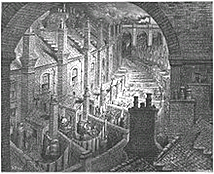
Fig.7.1b: 1870 picture of London as a densely populated industrial city
Fig.7.1: Health Issues due to Industrial Revolution
LESSONS FROM INDUSTRIAL REVOLUTIONWrite to Me | Comments | Related Articles | Top Most of us are familiar with the turmoil of the Industrial Revolution. It took generations for man to come to terms with the changes brought about by the industrial revolution. Man went through the turmoil of that revolution and finally came to terms with the change. (Ref.2, Managers' Guide..) People who went through it were not aware that they were going through a turmoil of industrial revolution. It was only later that we realized as hindsight that the pain they went through was due to the changeover to industrial era. Similarly, we are all going through the pain and turmoil of the information revolution right now. Most of us may not be even aware of it. "Turmoil of the Information revolution?" you may therefore ask, "What turmoil? The computerization scenario looks very euphoric. Computers are proliferating business organizations and entering every walk of our life. So where is the turmoil?" Just as man did not realize he was going through the turmoil of the industrial revolution till it was all over, we are not aware of the turmoil we are passing through. We had a close look at the conflicts and turbulence in most of the companies trying to automate processes. It is evident that deep inside, this technology is still foreign to us. Man is still not at ease with this device. He is perplexed, foxed, fidgety and sometimes angry when dealing with this animal. As we saw in previous sections, this leads to considerable friction, frustration and conflicts between departments. In this paper we will examine why we are not at ease with computers. The situation is chaotic globally, including in developed countries- because it is related to fundamental human instincts and mind-set. It is a problem of the evolution of human psychology from the era of industrial revolution to the information age. Managers, therefore, need to evolve from the industrial-age psychology to the information age to successfully face the challenges thrown by IT-driven changes. Implementation of computerized systems, particularly business application systems, is a major problem in most countries. Most of the computerization projects fail because of poor implementation and people-related issues and not technical issues. It is due to the way people, particularly senior managers react to computerization and what they understand or misunderstand about computers. The gap between computer users and computer professionals is evident. And so is the turmoil of the information revolution. There is a need to address this issue. Surprisingly most IT forums and conferences discuss vividly about technology and the "bits and bytes". But rarely is the people issue addressed, which is the primary cause of failures. Rarely do we talk of the implementation issues or deliberate on bridging the gap between people and this technology. The turmoil of the information revolution should not be pushed under the carpet but discussed threadbare and openly. Why don't computers find a smooth entry into the minds and lives of human beings? What is the root cause of this confusion? There are few fundamental problems in man's perception and understanding of computers, due to which however hard he tries to be at ease with them, he finds himself jittery and confused.1. Legacy of the Machine Age Mind-set
The first problem has to do with our mental make-up which has been shaped and groomed in the machine age and is unable to adjust itself in an age of computers.
2. Myths and MisconceptionsWrite to Me | Comments | Related Articles | Top There are various misconceptions about computers, but the ones discussed here are those which arose out of "Living-in-the-Past-Syndrome". We are still living in the Machine-Age and not opening our eyes to the fact that a new era has dawned.Myth 1: The computer is an electronic machine that can carry out amazing multifarious tasks. Truth 1: The Real Information-Age Machine is Software, not Computer The first and root cause of misconceptions about this technology arise out of our wrong perception of the real machine of the information era. We have been looking at the computer as the machine of the information age. The real machine of the information age is not the computer but the software running inside. The computer is only the fuel running it. The 'miraculous machine' that produces the wonderful results is not the computer, but the software running inside the computer. With our Machine age mind-set, we are used to seeing one machine perform one task, as in a car which performs the motor task. Since we wrongly look at the computer as the machine performing our task, we get bewildered to see the same machine performing so many tasks. Somewhere it is keeping accounts, somewhere else paying your employees the salary, somewhere replacing your astrologer to give you your forecast, somewhere designing a machine, somewhere else controlling a factory, and so on. This leaves the common man awe-struck, and really confused. This gives rise to his unrealistic expectation from the computer. He feels the computer can do anything. With such an image of the computer in our minds, we expect computers to perform miracles. We mistake it to be flexible also and expect it to adopt to our ways. But when it does not, we get frustrated. Over the centuries we have got so used to the machine of Industrial-age that we expect computers to behave exactly like any other machine. We have learnt to think 'mechanically' (or in terms of mechanical sequence of movements or actions). The mechanization culture has seeped into our very mind-set which we need to unlearn. Myth 2: The computer is a very versatile, superior and efficient machine. Truth 2: 'Computer' is Far Inferior to a Machine age Machine We think that the computer is very versatile and far superior when compared to other machines of the machine age. Since we are immensely satisfied with the industrial-age machines, we expect bigger miracles and more satisfaction from computers. This is where our biggest folly lies. With such high expectations, naturally there is more frustration. Actually, the computer (or the 'software machine') is far inferior when compared to a machine of the machine age. This may sound incredible, but is true. Whereas the machine is clearly superior to man with respect to the physical functions that it automates, the computer falls far short of man and his brain in the mental functions which it attempts to simulate. We still see it as the same machine and expect it to give similar benefits as the machines did. The computer can post and print a thousand ledger entries in no time which a man would take days - but where a human being could detect a common sense error, the computer fails miserably. Deep inside, we are still not ready to accept this. We have not yet realized the difference between Industrial Revolution and Information Revolution. Computerization is not just introducing a new machine, it is the question of introducing a new culture of the new era. There is a very subtle difference in the way we should look at computers. When we realize this distinction, there will be a marked difference in our comprehension of computers, and our understanding of computers will be much clearer. Managers need to remove these misconceptions about computers. They need to change their machine-age mind-set in order to see computers in the right perspective. The computer is very different from a machine of the industrial-age. The differences between software machine and the machine-age machine are discussed at length in the article at Ref.1 ("What Top Executives Need To Know About Computers") 3. How to deal with the Turmoil of Information AgeHaving gone through the turmoil of the industrial revolution, we should be wiser to deal with the turmoil of this new revolution.First, let us acknowledge that we are all going through the inevitable. It is not just you and I, but the whole humanity is going through the troubled times. Doesn't that make you feel better? The next time you feel agitated and frustrated during computerization, just sit back and think that you are not alone. You can keep your cool and that will really help. Second, let us learn from the lessons learnt from Industrial revolution. We did not benefit from the Industrial machines for free, we did give something so that we could reap the benefits. To understand what we gave during the industrial revolution, let us compare the case of an industrial-age machine (aircraft) and the information-age machine (the computer or software). In the same vein, if we gave something to benefit from the industrial revolution, there must be something that we need to give to benefit from the information revolution. Are we giving what we are required to give? Are there any rules of the game? Are we playing by the rules of the game? 4. Comparing Aircraft to ComputersI was once discussing the issue of computerization with a friend. I said that we fail to use computers effectively because we are quite ignorant about computers. We do not have enough computer awareness. His immediate response was, "Why do I need to know about computers in order to use it? You are asking for too much from a computer user. When I travel by airplane, I do not know how it works. I do not know its inner parts or its aerodynamic principles but I can still make full use of the airplane to the best of my advantage. I may not know how my car works, but that does not stop me from getting the most out of my car. Then why do I need to know about computers to effectively use it? Why is the computer so demanding?"His argument sounds very logical and justified on the face of it. But there is a flaw. The argument that we do not know anything about an airplane or a car is not really true. We know far more about them than we know about computers. What is interesting is that we are not even aware of what we know about airplanes and cars, and what we do not know about computers. We may not know anything about the inner parts of a car or an airplane, but we certainly are very clear of what is expected of us to use them effectively. We at least know that the airplane cannot be used unless there is a long airstrip and a big open space to take off. We know that however far the aerodrome is, we have to use a taxi or a car to go to the airport and avail the services of the aircraft. We know what our responsibility is, we know that the aircraft will not pick us up from our residence. We know that the aircraft benefits us, provided we take the pains to start at least a few hours early, labour our way to the remote airport, go through the inconvenience of security checks, and wait for several minutes or hours. We never complain about all that. We know that a car can pick us up from our house and take us to the airport, but it cannot take us to a distant city in a few hours as an airplane does. We know that a car cannot be used effectively unless we build good roads. We are so used to the machines now that we immediately know that if we have to go to a distant city, we must use a plane; if we want to go shopping in town, we must take the car. If we have to visit a friend a few blocks away, we would rather walk up to the friend's place than use the car. We are now so used to these machines that we know immediately when to use which machine, and when not to use a machine. We take these decisions subconsciously in split seconds. We have learnt to benefit from their merits and live with their shortcomings. We are not even aware of the pains we take in order to take advantage of their strength. Would you call that knowing a lot about cars and aircrafts? Yes, because in the case of computers we do not even have this simple awareness. In case of computers we do not even know our responsibility. If we were to draw an analogy of our approach to computers with that to the aircraft, we expect an aircraft to come to our house to pick us up and take us to our office a few kilometres away. If it doesn't, we curse the 'aircraft'. This leads to frustration. We don't realize that the 'aircraft' is not designed for such services. If we expect the service of a car from an aircraft, then something is wrong with our expectation. This exactly is our ignorance with computers. 5. What we Gave to Gain from Industrial-age TechnologyLook at the pains we have taken to use technology of the industrial-age (Fig.7.2). We built roads to use cars, airstrip and airports for aircrafts, long rail lines for railways, etc. We built tall transmission towers and insulated wiring to use electricity. Electricity can be very useful, but at the same time it can also kill. When this technology was introduced I am sure there must have been a great deal of resistance to using it. But now we do not complain. We make safety provisions and we use it.
Fig.7.2: Demands of Industrial Technology/Machine Age machines There are mishaps when lives are lost. We no more blame electricity for such mishaps. Similarly, software, the devise of the Information Age, has some prerequisites. Most often, we do not even identify these prerequisites, leave alone implement them. We tend to blame the technology if it does not yield results. WHAT WE NEED TO GIVE TO GAIN FROM INFORMATION TECHNOLOGY
For computers, too, there must be certain rules of the game to get the best benefits.
PITFALLS AND RULES OF THE GAMEWe saw some of the pitfalls of IT in the previous sections. Behavioral IT Model has identified 11 pitfalls or serious weaknesses of this new information technology which are not very obvious but are responsible for most of the failures and confusion related to this technology. Corresponding to these 11 pitfalls, there are 11 rules of the game to avoid these pitfalls (Ref. 4, Seminar on Behavior IT). CHAPTER 8: BEHAVIORAL IT SOFT SKILLWrite to Me | Comments | Related Articles | Top
This chapter discusses the soft skills component of the Behavioral IT Model which tries to fill the gaps in behavioural skills that are required by managers during the IT Implementation process.
CURRENT MODEL OF FORCED LEARNING
MISCONCEPTIONS/MYTHS
Prem has found that there exist highly distorted beliefs and myths about
Fallacies about IT Technology:
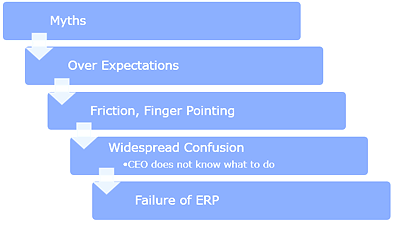
Fig.8.3: Myths about IT Lead to Failure Learning about Myths and realities gives real insights and awareness which creates empathy in both parties (IT and users), removes barriers between people and helps build a strong team (Fig.8.4). When these teams collaborate and work in sync, there are very little chances of failure. 2. How does Knowing Reality Help 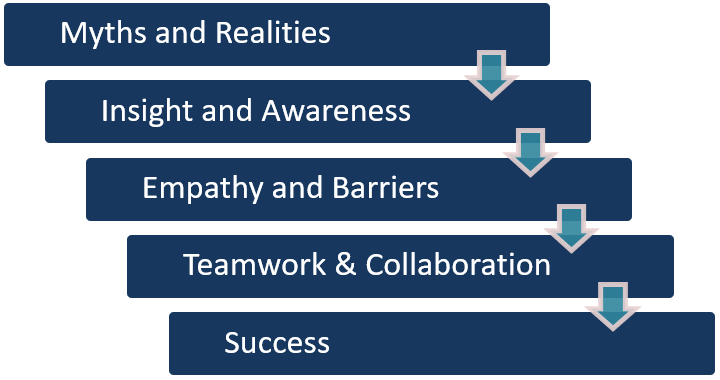
Fig.8.4: Awareness Leads to Success SOFT SKILL TO GET THE BEST OUT OF YOUR IT FOLKS AND YOUR SUBORDINATES
Behavioral IT soft skills give you tips to strike the best relation with IT department folks (Ref. 4, Seminar on Behavior IT). The IT folks will no longer be what you know them to be, they would be too eager to help you - in fact you would be their most preferred customer, their most sought after partner and their best buddy, the darling of IT.
CHAPTER 9: BEHAVIORAL IT MODEL OF IT TRANSFORMATIONWrite to Me | Comments | Related Articles | Top
Behavioral IT Model for IT Transformations provides the strategy for Businesses to avoid IT failures.
Fig.9.1 The four "demons" of IT-Driven Change: Technology, IT People, Processes and Your own Team. Benefits for You: Learn to manage the four "demons" and be in complete control
STRATEGIC ISSUES: LOPSIDED EMPHASIS ON TRAINING
Prem's Model ensures that the imbalance of bahavioral training to user departments and to CEOs is corrected. Most companies focus more on technical training and product training. Prem's Model emphasizes on imparting the skills the stake holders' need during implementation, which is the most vulnerable stage with respect to people issues.
ORGANIZATIONAL ISSUESBehavioral IT Model lays great emphasis on clearly defining the organisation, roles & responsibilities and the authority structure, because they play a very crucial role in the success of computerization. MANAGEMENT ISSUES - MANAGING IT- DRIVEN CHANGE
Prem's Model has special trainings for the change drivers of the organization. In fact the model's main component is a specialized training on managing IT-Driven change, with contents which is rarely covered in other change management courses. Though the training is imparted to most of the senior managers, CEO is the primary change driver in any company.
DO'S AND DON'TSPrem's Model has a list of Do's and Don'ts for every level of manager - user project manager, Head of Department and for the CEO which helps to ensure that the project does not fail (Ref.3, Behavioral IT). CONCLUSIONSWrite to Me | Comments | Related Articles | Top Behavioral IT Model helps to
eJournals Where this Article is Published
This article has been published as an academic paper in the following eJournals/Issues. You may need to login to ssrn.com site to view details of these journals. At this link at ssrn site, however, you can read the abstract of the paper and also download a pdf copy of the article. You do not need to log in to do so.
Go Back | Go Top Go Top REFERENCES:
1. Prem Kamble, "What Top Executives Need To Know About Computers" https://premkamble.com/probfull
|

 (This paper is a part of a series of articles and research papers on Behavioral IT®. Click on
(This paper is a part of a series of articles and research papers on Behavioral IT®. Click on 